Biomedical Engineering Course: Challenge Questions and Answers
VerifiedAdded on 2022/08/21
|14
|3019
|21
Homework Assignment
AI Summary
This assignment presents a comprehensive set of answers to challenge questions in biomedical engineering, covering a range of topics. The questions delve into the functionality and operation of defibrillators, including waveform types, modes of operation (cardioversion, pacing), and troubleshooting. ECG analysis is explored, including lead configurations, waveform views, arrhythmia detection, and the roles of a Biomed in testing and ensuring accurate readings. The document also examines Holter recorders, their applications in monitoring cardiac activity, and their differences from standard ECGs, including testing procedures and artifact identification. Finally, the assignment addresses treadmill stress test systems, their protocols, and the interpretation of results in the context of coronary artery disease. The answers provide detailed explanations and insights into the principles and practices of biomedical engineering.

Running head: BIOMEDICAL ENGINEERING
QUESTION AND ANSWERS
Name of the Student
Name of the University
Author Note
QUESTION AND ANSWERS
Name of the Student
Name of the University
Author Note
Paraphrase This Document
Need a fresh take? Get an instant paraphrase of this document with our AI Paraphraser
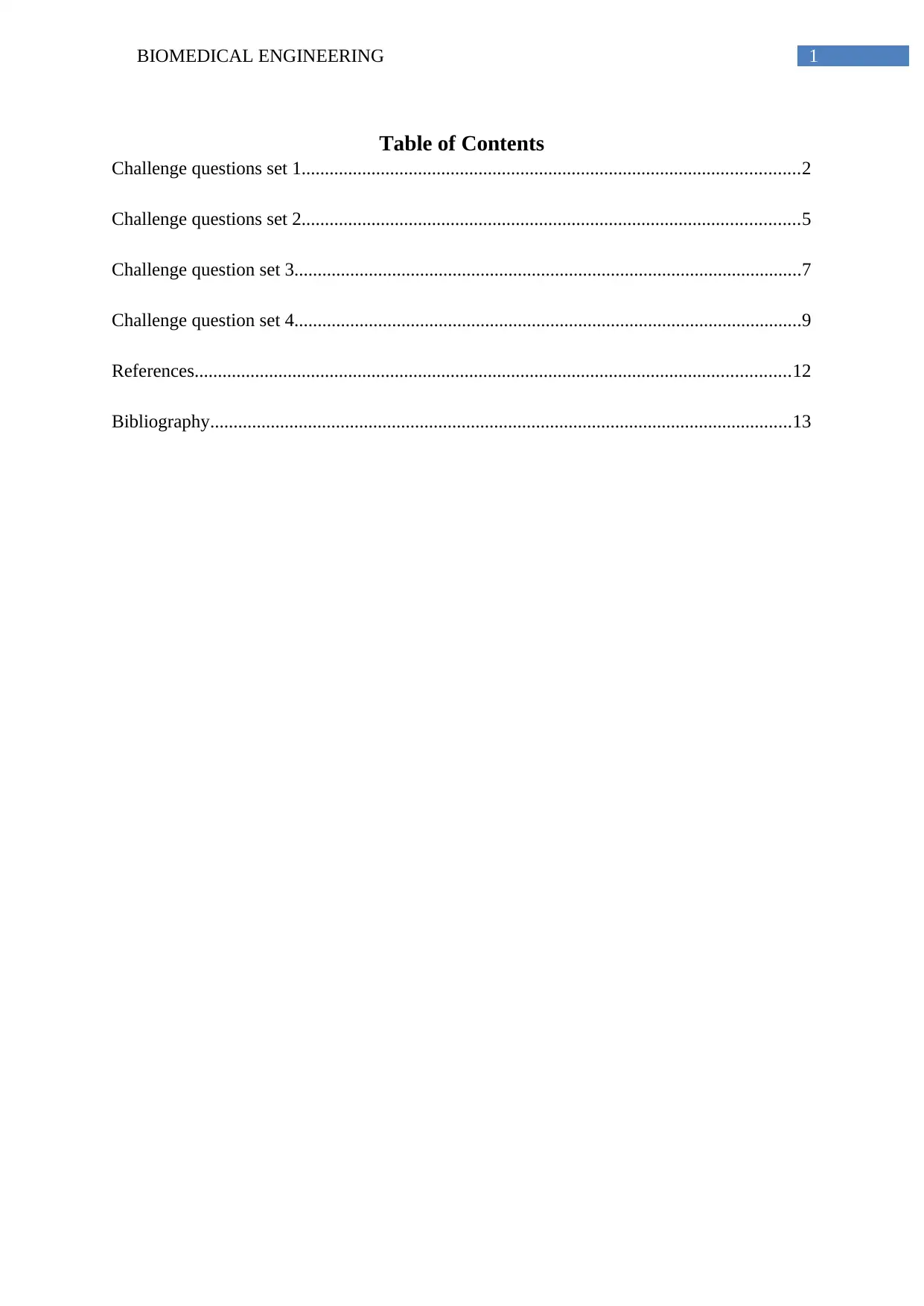
1BIOMEDICAL ENGINEERING
Table of Contents
Challenge questions set 1...........................................................................................................2
Challenge questions set 2...........................................................................................................5
Challenge question set 3.............................................................................................................7
Challenge question set 4.............................................................................................................9
References................................................................................................................................12
Bibliography.............................................................................................................................13
Table of Contents
Challenge questions set 1...........................................................................................................2
Challenge questions set 2...........................................................................................................5
Challenge question set 3.............................................................................................................7
Challenge question set 4.............................................................................................................9
References................................................................................................................................12
Bibliography.............................................................................................................................13

2BIOMEDICAL ENGINEERING
This paper will answer all the challenge questions associated with the paper given in
bibliography.
Challenge questions set 1
Answer 1- The main purpose of a defibrillator is to correct the electrical activity performed
by the human heart. A defibrillator has been designed to deliver a shock to the heart that
depolarizes the entire heart and may restore the normal sinus rhythm and save the life of
patient1.
Answer 2- The charge is stored in the battery of the defibrillator. The correct operation of the
battery is required to ensure the correct operation of all user nodes.
Answer 3- The two types of defibrillator waveform outputs are monophasic waveform and
biphasic waveform. Monophasic waveforms are a type of defibrillation waveform in which a
shock is delivered from only a single vector. In biphasic defibrillation, the waveform is
directed from two directions2.
Answer 4- A defibrillator ICD sends a strong shock. This shock is responsible for stopping
the heart rhythm and in turn, helps the heart to go back to a normal state. This device can act
as a pacemaker and finally brings the heart rate to normal.
Answer 5: There are two modes of operations used to correct ventricular fibrillation. These
modes of operation are coronary angioplasty and stent placement. These two operations open
up the blocked coronary arteries which let the blood flow freely inside the ventricular
1Køber, Lars, Jens J. Thune, Jens C. Nielsen, Jens Haarbo, Lars Videbæk, Eva Korup, Gunnar Jensen et
al. "Defibrillator implantation in patients with nonischemic systolic heart failure." New England Journal of
Medicine 375, no. 13 (2016): 1221-1230.
2Olgin, Jeffrey E., Mark J. Pletcher, Eric Vittinghoff, Jerzy Wranicz, Rajesh Malik, Daniel P. Morin,
Steven Zweibel et al. "Wearable cardioverter-defibrillator after myocardial infarction." New England Journal of
Medicine 379, no. 13 (2018): 1205-1215.
This paper will answer all the challenge questions associated with the paper given in
bibliography.
Challenge questions set 1
Answer 1- The main purpose of a defibrillator is to correct the electrical activity performed
by the human heart. A defibrillator has been designed to deliver a shock to the heart that
depolarizes the entire heart and may restore the normal sinus rhythm and save the life of
patient1.
Answer 2- The charge is stored in the battery of the defibrillator. The correct operation of the
battery is required to ensure the correct operation of all user nodes.
Answer 3- The two types of defibrillator waveform outputs are monophasic waveform and
biphasic waveform. Monophasic waveforms are a type of defibrillation waveform in which a
shock is delivered from only a single vector. In biphasic defibrillation, the waveform is
directed from two directions2.
Answer 4- A defibrillator ICD sends a strong shock. This shock is responsible for stopping
the heart rhythm and in turn, helps the heart to go back to a normal state. This device can act
as a pacemaker and finally brings the heart rate to normal.
Answer 5: There are two modes of operations used to correct ventricular fibrillation. These
modes of operation are coronary angioplasty and stent placement. These two operations open
up the blocked coronary arteries which let the blood flow freely inside the ventricular
1Køber, Lars, Jens J. Thune, Jens C. Nielsen, Jens Haarbo, Lars Videbæk, Eva Korup, Gunnar Jensen et
al. "Defibrillator implantation in patients with nonischemic systolic heart failure." New England Journal of
Medicine 375, no. 13 (2016): 1221-1230.
2Olgin, Jeffrey E., Mark J. Pletcher, Eric Vittinghoff, Jerzy Wranicz, Rajesh Malik, Daniel P. Morin,
Steven Zweibel et al. "Wearable cardioverter-defibrillator after myocardial infarction." New England Journal of
Medicine 379, no. 13 (2018): 1205-1215.
⊘ This is a preview!⊘
Do you want full access?
Subscribe today to unlock all pages.

Trusted by 1+ million students worldwide

3BIOMEDICAL ENGINEERING
fibrillation that was the main reason for heart attack. This process has been found to reduce
the risk of ventricular fibrillation episodes.
Answer 6- The most common mode of operation used to treat atrial fibrillation is
cardioversion. The cardioversion mode of defibrillator operation has been found to deliver a
synchronized shock. This function depolarizes all the exited tissues present in the circuit and
makes the tissues refractory in nature.
Answer 7- Paced mode of operation is needed for the correction of sinus bradycardia.
Answer 8- The four modes of defibrillator operation are:
1. Manual defibrillation
2. AED
3. Elective cardioversion
4. Pacer modes
Answer 9- Cardiovesion mode of defibrillator operation has been found to deliver a
synchronized shock. This function depolarizes all the exited tissues present in the circuit and
makes the tissues refractory in nature. SYNC mode key helps in the detection of patient R
waves in an ECG curve and after pressing the shock button the unit discharges and finally
moves to the next wave2.
Answer 10- Inpatient cases where the requirement is an electric shock and when the patient is
unstable, one can use the low energy synchronized cardioversion (SYNC). High energy
SYNC cardioversion is required when the patient is pulseless or unstable.
An electrical capture occurs as soon as the pacing stimulus has depolarized the
ventricles.
fibrillation that was the main reason for heart attack. This process has been found to reduce
the risk of ventricular fibrillation episodes.
Answer 6- The most common mode of operation used to treat atrial fibrillation is
cardioversion. The cardioversion mode of defibrillator operation has been found to deliver a
synchronized shock. This function depolarizes all the exited tissues present in the circuit and
makes the tissues refractory in nature.
Answer 7- Paced mode of operation is needed for the correction of sinus bradycardia.
Answer 8- The four modes of defibrillator operation are:
1. Manual defibrillation
2. AED
3. Elective cardioversion
4. Pacer modes
Answer 9- Cardiovesion mode of defibrillator operation has been found to deliver a
synchronized shock. This function depolarizes all the exited tissues present in the circuit and
makes the tissues refractory in nature. SYNC mode key helps in the detection of patient R
waves in an ECG curve and after pressing the shock button the unit discharges and finally
moves to the next wave2.
Answer 10- Inpatient cases where the requirement is an electric shock and when the patient is
unstable, one can use the low energy synchronized cardioversion (SYNC). High energy
SYNC cardioversion is required when the patient is pulseless or unstable.
An electrical capture occurs as soon as the pacing stimulus has depolarized the
ventricles.
Paraphrase This Document
Need a fresh take? Get an instant paraphrase of this document with our AI Paraphraser
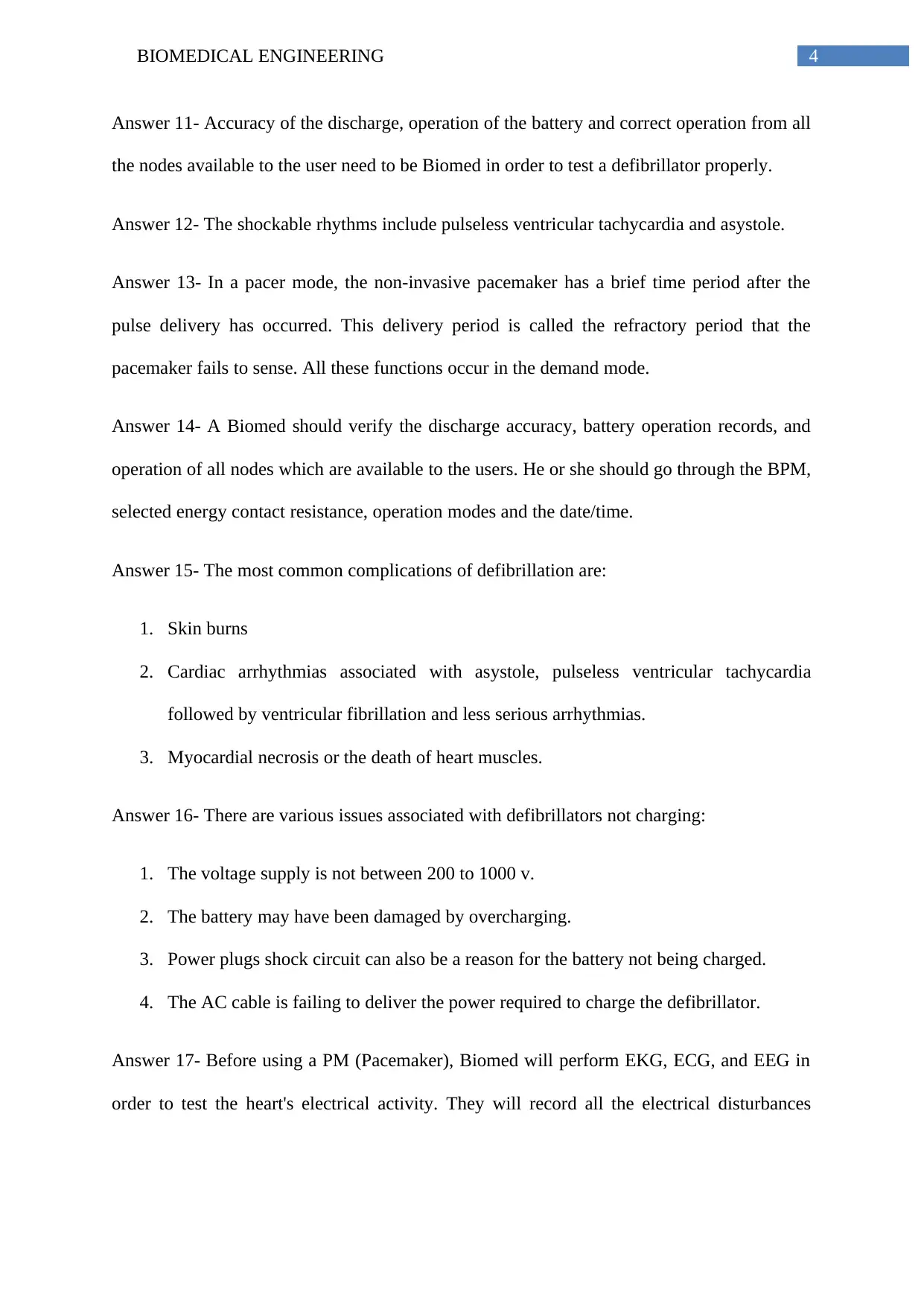
4BIOMEDICAL ENGINEERING
Answer 11- Accuracy of the discharge, operation of the battery and correct operation from all
the nodes available to the user need to be Biomed in order to test a defibrillator properly.
Answer 12- The shockable rhythms include pulseless ventricular tachycardia and asystole.
Answer 13- In a pacer mode, the non-invasive pacemaker has a brief time period after the
pulse delivery has occurred. This delivery period is called the refractory period that the
pacemaker fails to sense. All these functions occur in the demand mode.
Answer 14- A Biomed should verify the discharge accuracy, battery operation records, and
operation of all nodes which are available to the users. He or she should go through the BPM,
selected energy contact resistance, operation modes and the date/time.
Answer 15- The most common complications of defibrillation are:
1. Skin burns
2. Cardiac arrhythmias associated with asystole, pulseless ventricular tachycardia
followed by ventricular fibrillation and less serious arrhythmias.
3. Myocardial necrosis or the death of heart muscles.
Answer 16- There are various issues associated with defibrillators not charging:
1. The voltage supply is not between 200 to 1000 v.
2. The battery may have been damaged by overcharging.
3. Power plugs shock circuit can also be a reason for the battery not being charged.
4. The AC cable is failing to deliver the power required to charge the defibrillator.
Answer 17- Before using a PM (Pacemaker), Biomed will perform EKG, ECG, and EEG in
order to test the heart's electrical activity. They will record all the electrical disturbances
Answer 11- Accuracy of the discharge, operation of the battery and correct operation from all
the nodes available to the user need to be Biomed in order to test a defibrillator properly.
Answer 12- The shockable rhythms include pulseless ventricular tachycardia and asystole.
Answer 13- In a pacer mode, the non-invasive pacemaker has a brief time period after the
pulse delivery has occurred. This delivery period is called the refractory period that the
pacemaker fails to sense. All these functions occur in the demand mode.
Answer 14- A Biomed should verify the discharge accuracy, battery operation records, and
operation of all nodes which are available to the users. He or she should go through the BPM,
selected energy contact resistance, operation modes and the date/time.
Answer 15- The most common complications of defibrillation are:
1. Skin burns
2. Cardiac arrhythmias associated with asystole, pulseless ventricular tachycardia
followed by ventricular fibrillation and less serious arrhythmias.
3. Myocardial necrosis or the death of heart muscles.
Answer 16- There are various issues associated with defibrillators not charging:
1. The voltage supply is not between 200 to 1000 v.
2. The battery may have been damaged by overcharging.
3. Power plugs shock circuit can also be a reason for the battery not being charged.
4. The AC cable is failing to deliver the power required to charge the defibrillator.
Answer 17- Before using a PM (Pacemaker), Biomed will perform EKG, ECG, and EEG in
order to test the heart's electrical activity. They will record all the electrical disturbances
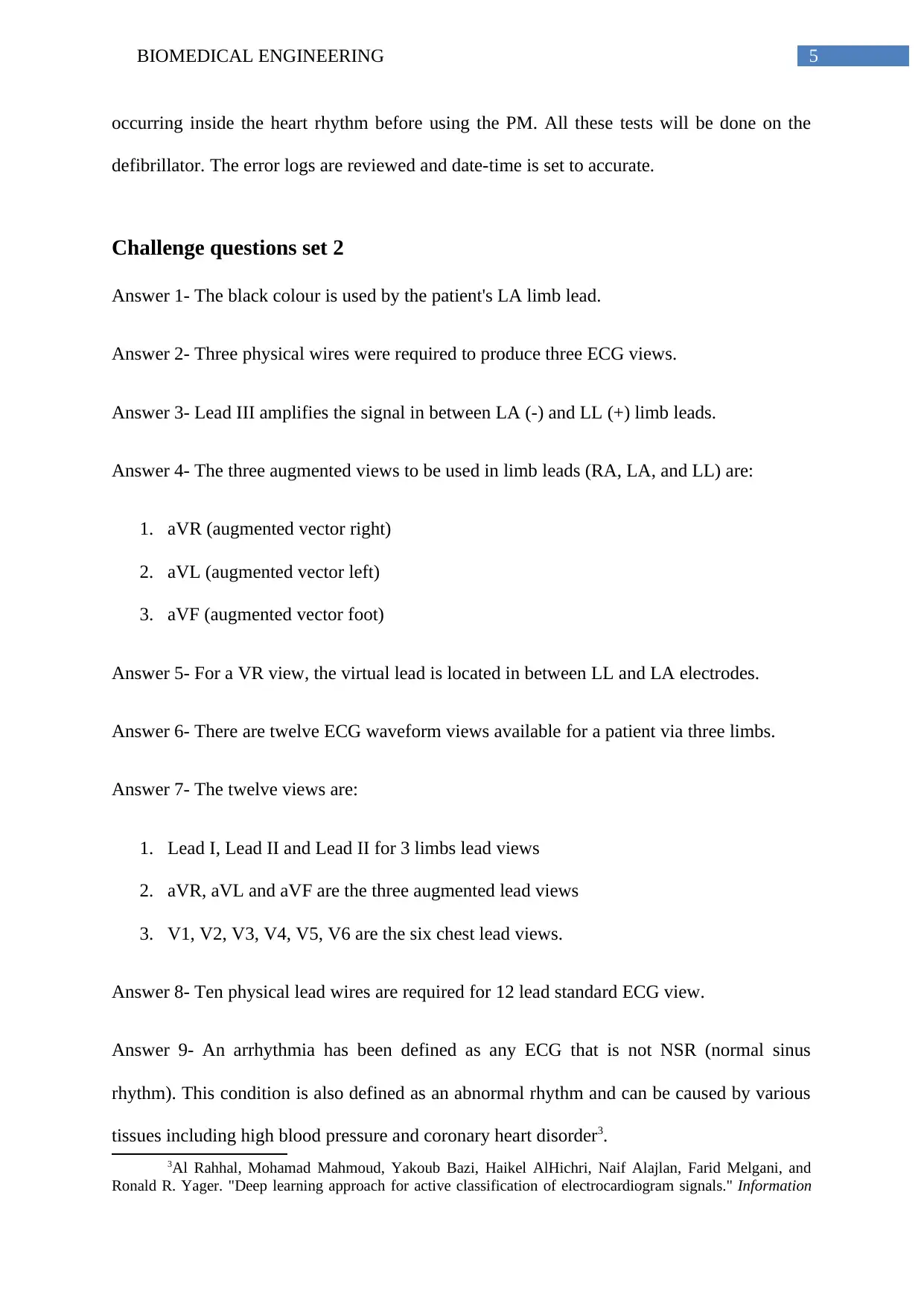
5BIOMEDICAL ENGINEERING
occurring inside the heart rhythm before using the PM. All these tests will be done on the
defibrillator. The error logs are reviewed and date-time is set to accurate.
Challenge questions set 2
Answer 1- The black colour is used by the patient's LA limb lead.
Answer 2- Three physical wires were required to produce three ECG views.
Answer 3- Lead III amplifies the signal in between LA (-) and LL (+) limb leads.
Answer 4- The three augmented views to be used in limb leads (RA, LA, and LL) are:
1. aVR (augmented vector right)
2. aVL (augmented vector left)
3. aVF (augmented vector foot)
Answer 5- For a VR view, the virtual lead is located in between LL and LA electrodes.
Answer 6- There are twelve ECG waveform views available for a patient via three limbs.
Answer 7- The twelve views are:
1. Lead I, Lead II and Lead II for 3 limbs lead views
2. aVR, aVL and aVF are the three augmented lead views
3. V1, V2, V3, V4, V5, V6 are the six chest lead views.
Answer 8- Ten physical lead wires are required for 12 lead standard ECG view.
Answer 9- An arrhythmia has been defined as any ECG that is not NSR (normal sinus
rhythm). This condition is also defined as an abnormal rhythm and can be caused by various
tissues including high blood pressure and coronary heart disorder3.
3Al Rahhal, Mohamad Mahmoud, Yakoub Bazi, Haikel AlHichri, Naif Alajlan, Farid Melgani, and
Ronald R. Yager. "Deep learning approach for active classification of electrocardiogram signals." Information
occurring inside the heart rhythm before using the PM. All these tests will be done on the
defibrillator. The error logs are reviewed and date-time is set to accurate.
Challenge questions set 2
Answer 1- The black colour is used by the patient's LA limb lead.
Answer 2- Three physical wires were required to produce three ECG views.
Answer 3- Lead III amplifies the signal in between LA (-) and LL (+) limb leads.
Answer 4- The three augmented views to be used in limb leads (RA, LA, and LL) are:
1. aVR (augmented vector right)
2. aVL (augmented vector left)
3. aVF (augmented vector foot)
Answer 5- For a VR view, the virtual lead is located in between LL and LA electrodes.
Answer 6- There are twelve ECG waveform views available for a patient via three limbs.
Answer 7- The twelve views are:
1. Lead I, Lead II and Lead II for 3 limbs lead views
2. aVR, aVL and aVF are the three augmented lead views
3. V1, V2, V3, V4, V5, V6 are the six chest lead views.
Answer 8- Ten physical lead wires are required for 12 lead standard ECG view.
Answer 9- An arrhythmia has been defined as any ECG that is not NSR (normal sinus
rhythm). This condition is also defined as an abnormal rhythm and can be caused by various
tissues including high blood pressure and coronary heart disorder3.
3Al Rahhal, Mohamad Mahmoud, Yakoub Bazi, Haikel AlHichri, Naif Alajlan, Farid Melgani, and
Ronald R. Yager. "Deep learning approach for active classification of electrocardiogram signals." Information
⊘ This is a preview!⊘
Do you want full access?
Subscribe today to unlock all pages.

Trusted by 1+ million students worldwide
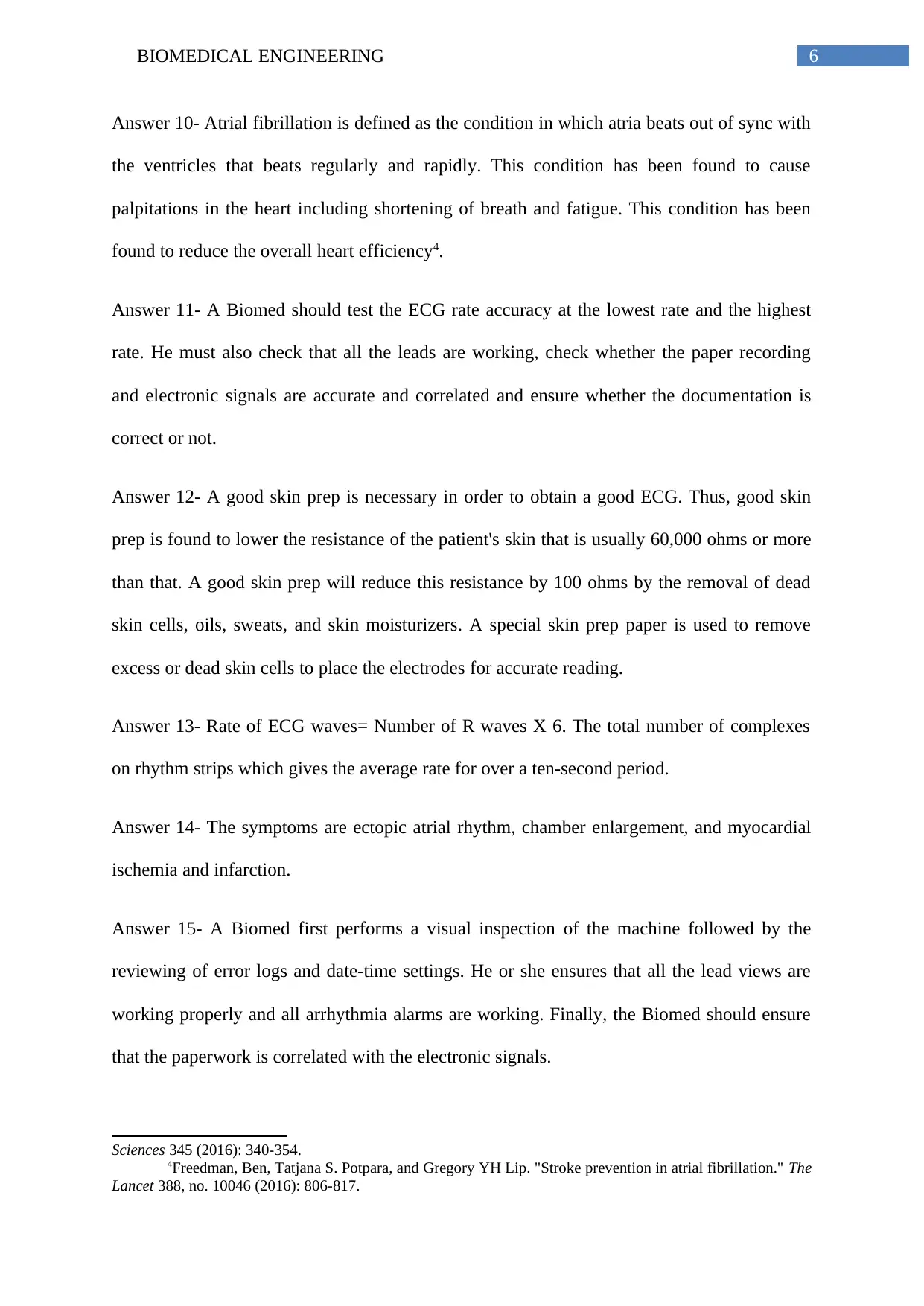
6BIOMEDICAL ENGINEERING
Answer 10- Atrial fibrillation is defined as the condition in which atria beats out of sync with
the ventricles that beats regularly and rapidly. This condition has been found to cause
palpitations in the heart including shortening of breath and fatigue. This condition has been
found to reduce the overall heart efficiency4.
Answer 11- A Biomed should test the ECG rate accuracy at the lowest rate and the highest
rate. He must also check that all the leads are working, check whether the paper recording
and electronic signals are accurate and correlated and ensure whether the documentation is
correct or not.
Answer 12- A good skin prep is necessary in order to obtain a good ECG. Thus, good skin
prep is found to lower the resistance of the patient's skin that is usually 60,000 ohms or more
than that. A good skin prep will reduce this resistance by 100 ohms by the removal of dead
skin cells, oils, sweats, and skin moisturizers. A special skin prep paper is used to remove
excess or dead skin cells to place the electrodes for accurate reading.
Answer 13- Rate of ECG waves= Number of R waves X 6. The total number of complexes
on rhythm strips which gives the average rate for over a ten-second period.
Answer 14- The symptoms are ectopic atrial rhythm, chamber enlargement, and myocardial
ischemia and infarction.
Answer 15- A Biomed first performs a visual inspection of the machine followed by the
reviewing of error logs and date-time settings. He or she ensures that all the lead views are
working properly and all arrhythmia alarms are working. Finally, the Biomed should ensure
that the paperwork is correlated with the electronic signals.
Sciences 345 (2016): 340-354.
4Freedman, Ben, Tatjana S. Potpara, and Gregory YH Lip. "Stroke prevention in atrial fibrillation." The
Lancet 388, no. 10046 (2016): 806-817.
Answer 10- Atrial fibrillation is defined as the condition in which atria beats out of sync with
the ventricles that beats regularly and rapidly. This condition has been found to cause
palpitations in the heart including shortening of breath and fatigue. This condition has been
found to reduce the overall heart efficiency4.
Answer 11- A Biomed should test the ECG rate accuracy at the lowest rate and the highest
rate. He must also check that all the leads are working, check whether the paper recording
and electronic signals are accurate and correlated and ensure whether the documentation is
correct or not.
Answer 12- A good skin prep is necessary in order to obtain a good ECG. Thus, good skin
prep is found to lower the resistance of the patient's skin that is usually 60,000 ohms or more
than that. A good skin prep will reduce this resistance by 100 ohms by the removal of dead
skin cells, oils, sweats, and skin moisturizers. A special skin prep paper is used to remove
excess or dead skin cells to place the electrodes for accurate reading.
Answer 13- Rate of ECG waves= Number of R waves X 6. The total number of complexes
on rhythm strips which gives the average rate for over a ten-second period.
Answer 14- The symptoms are ectopic atrial rhythm, chamber enlargement, and myocardial
ischemia and infarction.
Answer 15- A Biomed first performs a visual inspection of the machine followed by the
reviewing of error logs and date-time settings. He or she ensures that all the lead views are
working properly and all arrhythmia alarms are working. Finally, the Biomed should ensure
that the paperwork is correlated with the electronic signals.
Sciences 345 (2016): 340-354.
4Freedman, Ben, Tatjana S. Potpara, and Gregory YH Lip. "Stroke prevention in atrial fibrillation." The
Lancet 388, no. 10046 (2016): 806-817.
Paraphrase This Document
Need a fresh take? Get an instant paraphrase of this document with our AI Paraphraser

7BIOMEDICAL ENGINEERING
Answer 16- The specific tests are associated with the working process of arrhythmia which
includes HR above 100 and 60 BPM respectively for Tachycardia and Bradycardia
respectively. Both horizontal and vertical checks should be performed for the ECG machine.
Challenge question set 3
Answer 1- The main purpose of a Holter recorder has been found to record the dynamin
electrocardiogram of the patient. The Holter records the electrical activities of the heart
during normal activities. A Holter analyzer has been used to detect various arrhythmias such
as bradycardia, PVCs, atrial fibrillation and tachycardia5.
Answer 2- Three physical wires were required to produce three ECG views.
Answer 3- An arrhythmia has been defined as any ECG that is not NSR (normal sinus
rhythm). This condition is also defined as an abnormal rhythm and can be caused by various
tissues including high blood pressure and coronary heart disorder.
Answer 4- A Biomed should test the ECG rate accuracy at the lowest rate and the highest
rate. He must also check that all the leads are working, check whether the paper recording
and electronic signals are accurate and correlated and ensure whether the documentation is
correct or not.
Answer 5- A good skin prep is necessary in order to obtain a good ECG. Thus, good skin
prep is found to lower the resistance of the patient's skin that is usually 60,000 ohms or more
than that. A good skin prep will reduce this resistance by 100 ohms by the removal of dead
5Nakatani, Yuki, Atsuhiko Kawabe, Mihoko Matsumura, Yoshimasa Aso, Takanori Yasu, Nobuyuki
Banba, and Takaaki Nakamoto. "Effects of GLP-1 receptor agonists on heart rate and the autonomic nervous
system using Holter electrocardiography and power spectrum analysis of heart rate variability." Diabetes
Care 39, no. 2 (2016): e22-e23.
Answer 16- The specific tests are associated with the working process of arrhythmia which
includes HR above 100 and 60 BPM respectively for Tachycardia and Bradycardia
respectively. Both horizontal and vertical checks should be performed for the ECG machine.
Challenge question set 3
Answer 1- The main purpose of a Holter recorder has been found to record the dynamin
electrocardiogram of the patient. The Holter records the electrical activities of the heart
during normal activities. A Holter analyzer has been used to detect various arrhythmias such
as bradycardia, PVCs, atrial fibrillation and tachycardia5.
Answer 2- Three physical wires were required to produce three ECG views.
Answer 3- An arrhythmia has been defined as any ECG that is not NSR (normal sinus
rhythm). This condition is also defined as an abnormal rhythm and can be caused by various
tissues including high blood pressure and coronary heart disorder.
Answer 4- A Biomed should test the ECG rate accuracy at the lowest rate and the highest
rate. He must also check that all the leads are working, check whether the paper recording
and electronic signals are accurate and correlated and ensure whether the documentation is
correct or not.
Answer 5- A good skin prep is necessary in order to obtain a good ECG. Thus, good skin
prep is found to lower the resistance of the patient's skin that is usually 60,000 ohms or more
than that. A good skin prep will reduce this resistance by 100 ohms by the removal of dead
5Nakatani, Yuki, Atsuhiko Kawabe, Mihoko Matsumura, Yoshimasa Aso, Takanori Yasu, Nobuyuki
Banba, and Takaaki Nakamoto. "Effects of GLP-1 receptor agonists on heart rate and the autonomic nervous
system using Holter electrocardiography and power spectrum analysis of heart rate variability." Diabetes
Care 39, no. 2 (2016): e22-e23.
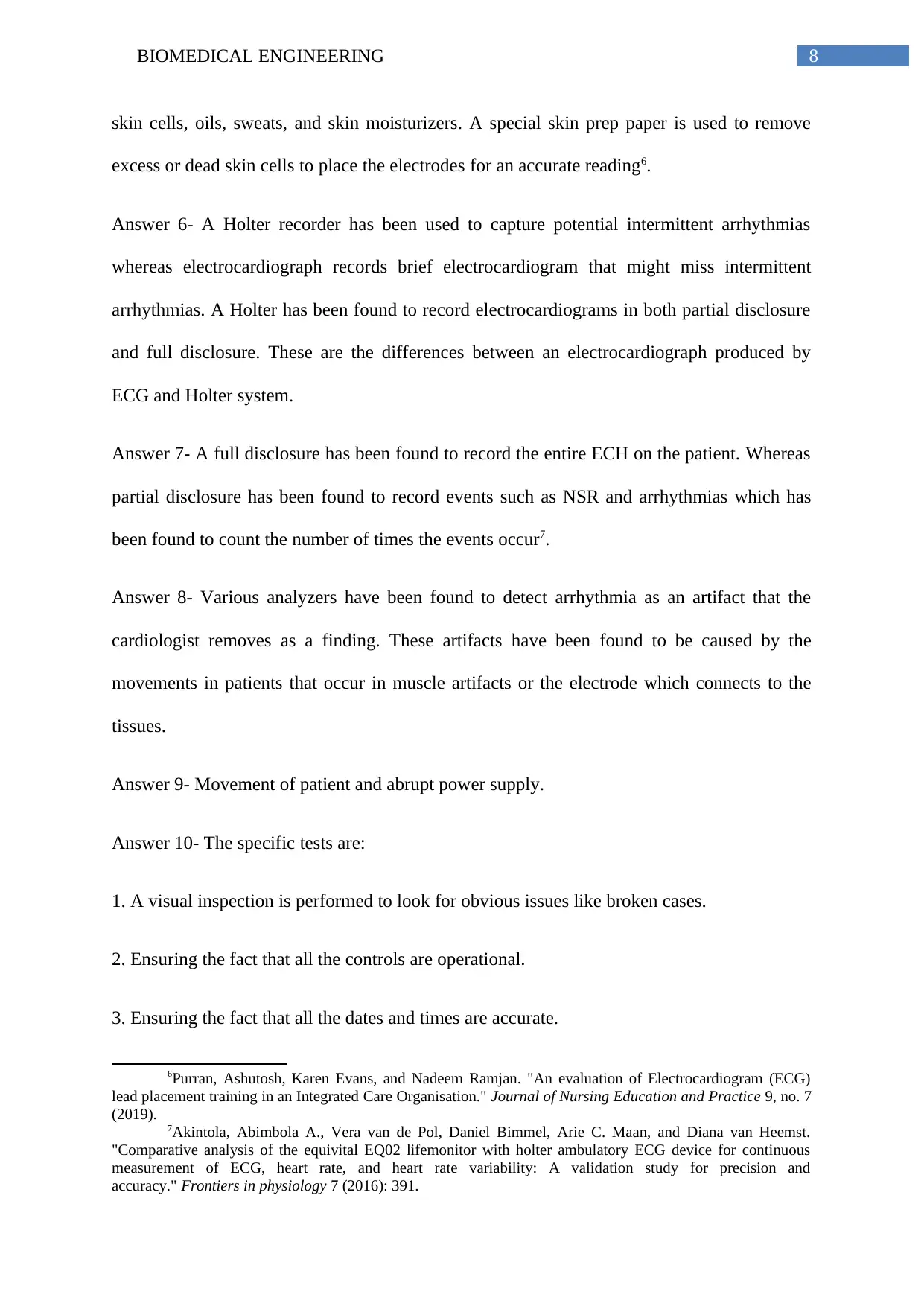
8BIOMEDICAL ENGINEERING
skin cells, oils, sweats, and skin moisturizers. A special skin prep paper is used to remove
excess or dead skin cells to place the electrodes for an accurate reading6.
Answer 6- A Holter recorder has been used to capture potential intermittent arrhythmias
whereas electrocardiograph records brief electrocardiogram that might miss intermittent
arrhythmias. A Holter has been found to record electrocardiograms in both partial disclosure
and full disclosure. These are the differences between an electrocardiograph produced by
ECG and Holter system.
Answer 7- A full disclosure has been found to record the entire ECH on the patient. Whereas
partial disclosure has been found to record events such as NSR and arrhythmias which has
been found to count the number of times the events occur7.
Answer 8- Various analyzers have been found to detect arrhythmia as an artifact that the
cardiologist removes as a finding. These artifacts have been found to be caused by the
movements in patients that occur in muscle artifacts or the electrode which connects to the
tissues.
Answer 9- Movement of patient and abrupt power supply.
Answer 10- The specific tests are:
1. A visual inspection is performed to look for obvious issues like broken cases.
2. Ensuring the fact that all the controls are operational.
3. Ensuring the fact that all the dates and times are accurate.
6Purran, Ashutosh, Karen Evans, and Nadeem Ramjan. "An evaluation of Electrocardiogram (ECG)
lead placement training in an Integrated Care Organisation." Journal of Nursing Education and Practice 9, no. 7
(2019). 7Akintola, Abimbola A., Vera van de Pol, Daniel Bimmel, Arie C. Maan, and Diana van Heemst.
"Comparative analysis of the equivital EQ02 lifemonitor with holter ambulatory ECG device for continuous
measurement of ECG, heart rate, and heart rate variability: A validation study for precision and
accuracy." Frontiers in physiology 7 (2016): 391.
skin cells, oils, sweats, and skin moisturizers. A special skin prep paper is used to remove
excess or dead skin cells to place the electrodes for an accurate reading6.
Answer 6- A Holter recorder has been used to capture potential intermittent arrhythmias
whereas electrocardiograph records brief electrocardiogram that might miss intermittent
arrhythmias. A Holter has been found to record electrocardiograms in both partial disclosure
and full disclosure. These are the differences between an electrocardiograph produced by
ECG and Holter system.
Answer 7- A full disclosure has been found to record the entire ECH on the patient. Whereas
partial disclosure has been found to record events such as NSR and arrhythmias which has
been found to count the number of times the events occur7.
Answer 8- Various analyzers have been found to detect arrhythmia as an artifact that the
cardiologist removes as a finding. These artifacts have been found to be caused by the
movements in patients that occur in muscle artifacts or the electrode which connects to the
tissues.
Answer 9- Movement of patient and abrupt power supply.
Answer 10- The specific tests are:
1. A visual inspection is performed to look for obvious issues like broken cases.
2. Ensuring the fact that all the controls are operational.
3. Ensuring the fact that all the dates and times are accurate.
6Purran, Ashutosh, Karen Evans, and Nadeem Ramjan. "An evaluation of Electrocardiogram (ECG)
lead placement training in an Integrated Care Organisation." Journal of Nursing Education and Practice 9, no. 7
(2019). 7Akintola, Abimbola A., Vera van de Pol, Daniel Bimmel, Arie C. Maan, and Diana van Heemst.
"Comparative analysis of the equivital EQ02 lifemonitor with holter ambulatory ECG device for continuous
measurement of ECG, heart rate, and heart rate variability: A validation study for precision and
accuracy." Frontiers in physiology 7 (2016): 391.
⊘ This is a preview!⊘
Do you want full access?
Subscribe today to unlock all pages.

Trusted by 1+ million students worldwide
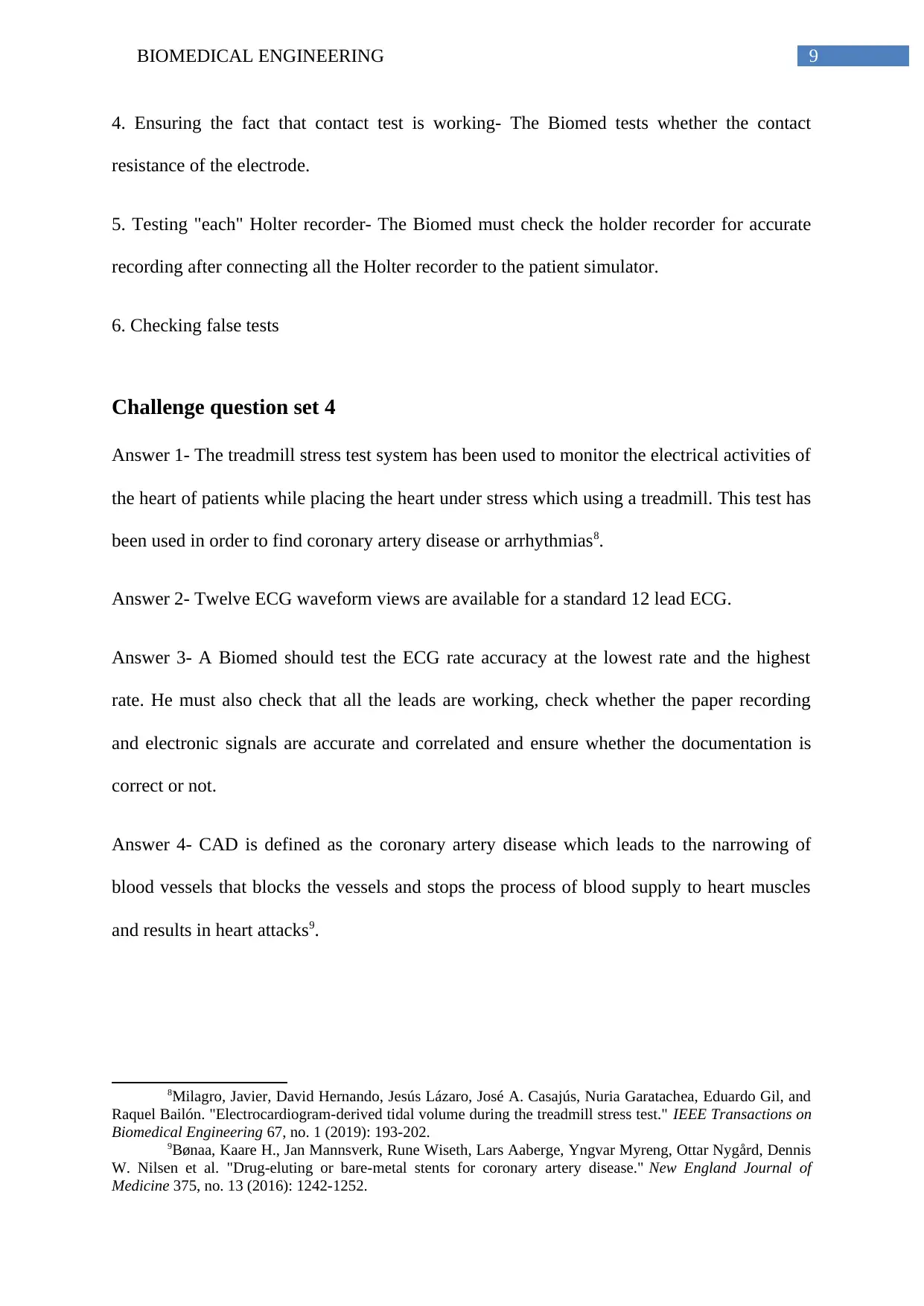
9BIOMEDICAL ENGINEERING
4. Ensuring the fact that contact test is working- The Biomed tests whether the contact
resistance of the electrode.
5. Testing "each" Holter recorder- The Biomed must check the holder recorder for accurate
recording after connecting all the Holter recorder to the patient simulator.
6. Checking false tests
Challenge question set 4
Answer 1- The treadmill stress test system has been used to monitor the electrical activities of
the heart of patients while placing the heart under stress which using a treadmill. This test has
been used in order to find coronary artery disease or arrhythmias8.
Answer 2- Twelve ECG waveform views are available for a standard 12 lead ECG.
Answer 3- A Biomed should test the ECG rate accuracy at the lowest rate and the highest
rate. He must also check that all the leads are working, check whether the paper recording
and electronic signals are accurate and correlated and ensure whether the documentation is
correct or not.
Answer 4- CAD is defined as the coronary artery disease which leads to the narrowing of
blood vessels that blocks the vessels and stops the process of blood supply to heart muscles
and results in heart attacks9.
8Milagro, Javier, David Hernando, Jesús Lázaro, José A. Casajús, Nuria Garatachea, Eduardo Gil, and
Raquel Bailón. "Electrocardiogram-derived tidal volume during the treadmill stress test." IEEE Transactions on
Biomedical Engineering 67, no. 1 (2019): 193-202.
9Bønaa, Kaare H., Jan Mannsverk, Rune Wiseth, Lars Aaberge, Yngvar Myreng, Ottar Nygård, Dennis
W. Nilsen et al. "Drug-eluting or bare-metal stents for coronary artery disease." New England Journal of
Medicine 375, no. 13 (2016): 1242-1252.
4. Ensuring the fact that contact test is working- The Biomed tests whether the contact
resistance of the electrode.
5. Testing "each" Holter recorder- The Biomed must check the holder recorder for accurate
recording after connecting all the Holter recorder to the patient simulator.
6. Checking false tests
Challenge question set 4
Answer 1- The treadmill stress test system has been used to monitor the electrical activities of
the heart of patients while placing the heart under stress which using a treadmill. This test has
been used in order to find coronary artery disease or arrhythmias8.
Answer 2- Twelve ECG waveform views are available for a standard 12 lead ECG.
Answer 3- A Biomed should test the ECG rate accuracy at the lowest rate and the highest
rate. He must also check that all the leads are working, check whether the paper recording
and electronic signals are accurate and correlated and ensure whether the documentation is
correct or not.
Answer 4- CAD is defined as the coronary artery disease which leads to the narrowing of
blood vessels that blocks the vessels and stops the process of blood supply to heart muscles
and results in heart attacks9.
8Milagro, Javier, David Hernando, Jesús Lázaro, José A. Casajús, Nuria Garatachea, Eduardo Gil, and
Raquel Bailón. "Electrocardiogram-derived tidal volume during the treadmill stress test." IEEE Transactions on
Biomedical Engineering 67, no. 1 (2019): 193-202.
9Bønaa, Kaare H., Jan Mannsverk, Rune Wiseth, Lars Aaberge, Yngvar Myreng, Ottar Nygård, Dennis
W. Nilsen et al. "Drug-eluting or bare-metal stents for coronary artery disease." New England Journal of
Medicine 375, no. 13 (2016): 1242-1252.
Paraphrase This Document
Need a fresh take? Get an instant paraphrase of this document with our AI Paraphraser
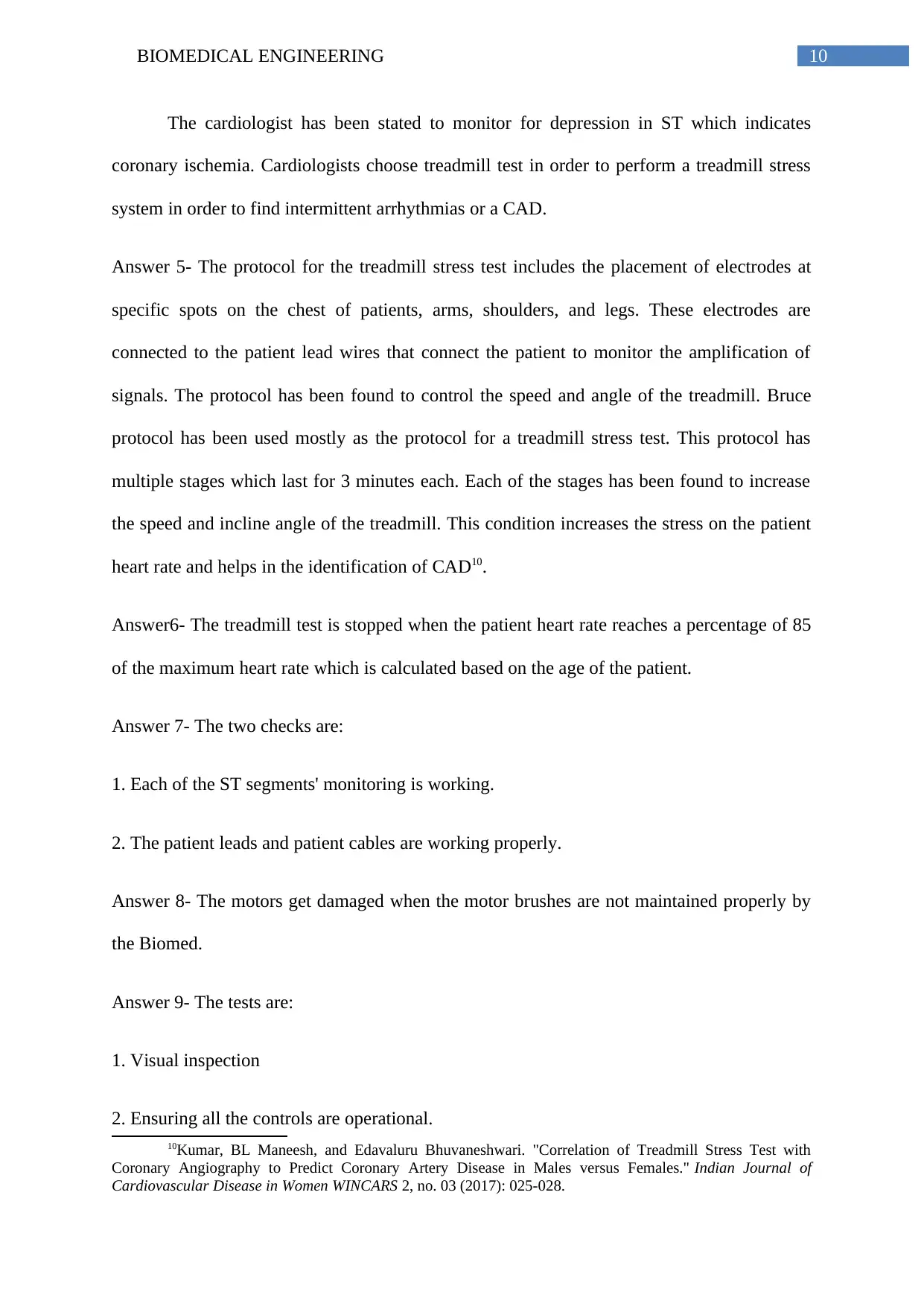
10BIOMEDICAL ENGINEERING
The cardiologist has been stated to monitor for depression in ST which indicates
coronary ischemia. Cardiologists choose treadmill test in order to perform a treadmill stress
system in order to find intermittent arrhythmias or a CAD.
Answer 5- The protocol for the treadmill stress test includes the placement of electrodes at
specific spots on the chest of patients, arms, shoulders, and legs. These electrodes are
connected to the patient lead wires that connect the patient to monitor the amplification of
signals. The protocol has been found to control the speed and angle of the treadmill. Bruce
protocol has been used mostly as the protocol for a treadmill stress test. This protocol has
multiple stages which last for 3 minutes each. Each of the stages has been found to increase
the speed and incline angle of the treadmill. This condition increases the stress on the patient
heart rate and helps in the identification of CAD10.
Answer6- The treadmill test is stopped when the patient heart rate reaches a percentage of 85
of the maximum heart rate which is calculated based on the age of the patient.
Answer 7- The two checks are:
1. Each of the ST segments' monitoring is working.
2. The patient leads and patient cables are working properly.
Answer 8- The motors get damaged when the motor brushes are not maintained properly by
the Biomed.
Answer 9- The tests are:
1. Visual inspection
2. Ensuring all the controls are operational.
10Kumar, BL Maneesh, and Edavaluru Bhuvaneshwari. "Correlation of Treadmill Stress Test with
Coronary Angiography to Predict Coronary Artery Disease in Males versus Females." Indian Journal of
Cardiovascular Disease in Women WINCARS 2, no. 03 (2017): 025-028.
The cardiologist has been stated to monitor for depression in ST which indicates
coronary ischemia. Cardiologists choose treadmill test in order to perform a treadmill stress
system in order to find intermittent arrhythmias or a CAD.
Answer 5- The protocol for the treadmill stress test includes the placement of electrodes at
specific spots on the chest of patients, arms, shoulders, and legs. These electrodes are
connected to the patient lead wires that connect the patient to monitor the amplification of
signals. The protocol has been found to control the speed and angle of the treadmill. Bruce
protocol has been used mostly as the protocol for a treadmill stress test. This protocol has
multiple stages which last for 3 minutes each. Each of the stages has been found to increase
the speed and incline angle of the treadmill. This condition increases the stress on the patient
heart rate and helps in the identification of CAD10.
Answer6- The treadmill test is stopped when the patient heart rate reaches a percentage of 85
of the maximum heart rate which is calculated based on the age of the patient.
Answer 7- The two checks are:
1. Each of the ST segments' monitoring is working.
2. The patient leads and patient cables are working properly.
Answer 8- The motors get damaged when the motor brushes are not maintained properly by
the Biomed.
Answer 9- The tests are:
1. Visual inspection
2. Ensuring all the controls are operational.
10Kumar, BL Maneesh, and Edavaluru Bhuvaneshwari. "Correlation of Treadmill Stress Test with
Coronary Angiography to Predict Coronary Artery Disease in Males versus Females." Indian Journal of
Cardiovascular Disease in Women WINCARS 2, no. 03 (2017): 025-028.

11BIOMEDICAL ENGINEERING
3. Ensuring the accuracy of data and time.
4. Reviewing error logs.
5. Ensuring the accuracy at multiple rates.
6. Ensuring the fact that all the lead views are working.
7. Ensuring that ECG high and low alarms are working
8. Ensuring the fact that all arrhythmia alarms are working
9. Ensuring the fact that monitoring of ST-segment is working.
10. Ensuring paper recording and electronic signals are correlated.
11. Testing whether the treadmill speed and angles are accurate or not.
12. Inspection or replacement of belts.
13. Testing motor brushes for any damage.
14. Ensuring accurate documentation.
3. Ensuring the accuracy of data and time.
4. Reviewing error logs.
5. Ensuring the accuracy at multiple rates.
6. Ensuring the fact that all the lead views are working.
7. Ensuring that ECG high and low alarms are working
8. Ensuring the fact that all arrhythmia alarms are working
9. Ensuring the fact that monitoring of ST-segment is working.
10. Ensuring paper recording and electronic signals are correlated.
11. Testing whether the treadmill speed and angles are accurate or not.
12. Inspection or replacement of belts.
13. Testing motor brushes for any damage.
14. Ensuring accurate documentation.
⊘ This is a preview!⊘
Do you want full access?
Subscribe today to unlock all pages.

Trusted by 1+ million students worldwide
1 out of 14
Your All-in-One AI-Powered Toolkit for Academic Success.
+13062052269
info@desklib.com
Available 24*7 on WhatsApp / Email
![[object Object]](/_next/static/media/star-bottom.7253800d.svg)
Unlock your academic potential
Copyright © 2020–2025 A2Z Services. All Rights Reserved. Developed and managed by ZUCOL.